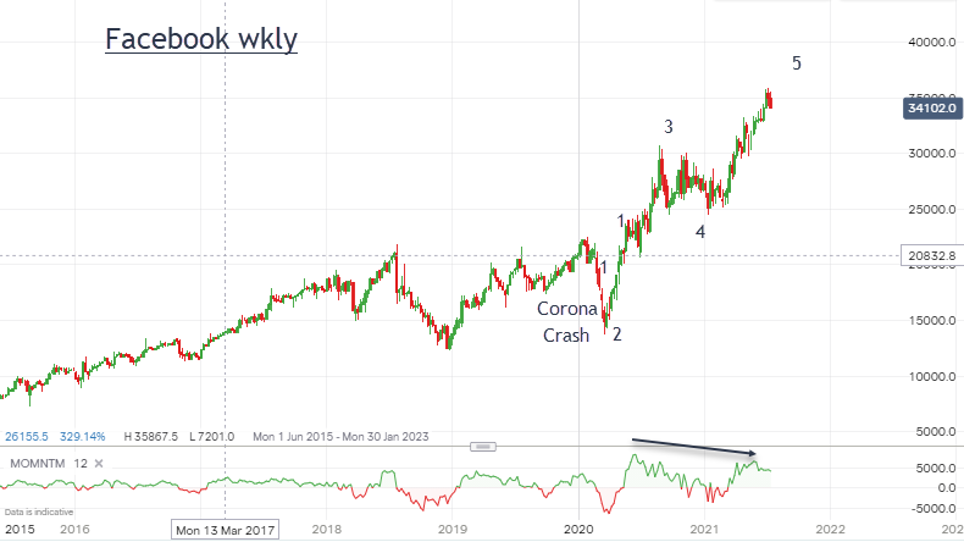Chart of the week: a new outlook for rebranded Facebook
1st November 2021 09:31
by John Burford from interactive investor
CEO MarkZuckerberg has changed Facebook’s name to Meta, but will it resurrect the struggling share price?

Facebook – will the new name Meta fly?
With this leading social media company in the direct firing line from all sides, Mark Zuckerberg has decided to change its name to – Meta (NASDAQ:FB). This has brought widespread derision from the sidelines (I have yet to read a supportive comment!).
It has been pointed out that 'Meta' means 'dead' in Hebrew, and my dictionary definition is 'showing or suggesting an explicit awareness of itself or oneself as a member of its category: cleverly self-referential'. Hmm. Sounds dangerously inward to me.
As some have asked, was this rebrand an attempt to divert attention away from the very negative press it is receiving? And/or is it to try to bolster the falling stock price with a focus on the 'metaverse' concepts?
Yes, the shares are down about 20% off its 1 September high. So was my COTW of July 19 prescient? Then I wrote: “I am venturing into the contrarian world (again) and putting my case that Facebook shares are likely topping and investors who take at least some profits here would be prudent.”
The shares traded then at the $360 region and were still in a major uptrend. Going against a major trend is usually considered financial suicide. But not always.
- Chart of the week: can Facebook withstand the President’s ire?
- Will US stocks be the ones to own in November too?
I pointed out that US president Joe Biden had then stated that Facebook was “killing people with Covid misinformation”, and that very powerful and highly unusual utterance from the 'leader of the free world' would likely be a watershed moment for social media platforms. In addition, the online abuse and death threats continue unabated.
So, is this a case of “What Mr Zuckerberg has created, he will also destroy?”
Here is the weekly chart posted in July:

Past performance is not a guide to future performance
I concluded that the shares were in the final fifth wave up and that the top was nearby given the momentum divergence.
Here is the updated daily chart showing my three trendlines that have been broken:

Past performance is not a guide to future performance
So, is this a 'three strikes and you're out' set-up? Odds are now strong a long-lasting bear trend started on 1 September, and only an unlikely move into a new all-time high could erase that forecast.
But with negative sentiment building, my first major downside target is the $260 region.
John Burford is the author of the definitive text on his trading method, Tramline Trading. He is also a freelance contributor and not a direct employee of interactive investor.
These articles are provided for information purposes only. Occasionally, an opinion about whether to buy or sell a specific investment may be provided by third parties. The content is not intended to be a personal recommendation to buy or sell any financial instrument or product, or to adopt any investment strategy as it is not provided based on an assessment of your investing knowledge and experience, your financial situation or your investment objectives. The value of your investments, and the income derived from them, may go down as well as up. You may not get back all the money that you invest. The investments referred to in this article may not be suitable for all investors, and if in doubt, an investor should seek advice from a qualified investment adviser.
Full performance can be found on the company or index summary page on the interactive investor website. Simply click on the company's or index name highlighted in the article.
Disclosure
We use a combination of fundamental and technical analysis in forming our view as to the valuation and prospects of an investment. Where relevant we have set out those particular matters we think are important in the above article, but further detail can be found here.
Please note that our article on this investment should not be considered to be a regular publication.
Details of all recommendations issued by ii during the previous 12-month period can be found here.
ii adheres to a strict code of conduct. Contributors may hold shares or have other interests in companies included in these portfolios, which could create a conflict of interests. Contributors intending to write about any financial instruments in which they have an interest are required to disclose such interest to ii and in the article itself. ii will at all times consider whether such interest impairs the objectivity of the recommendation.
In addition, individuals involved in the production of investment articles are subject to a personal account dealing restriction, which prevents them from placing a transaction in the specified instrument(s) for a period before and for five working days after such publication. This is to avoid personal interests conflicting with the interests of the recipients of those investment articles.